
You’ve probably noticed (as we certainly have) that achieving high open and reply rates have become much harder. Enter: The need for a smart email warm up process.
When open rates are consistently below 50%, reps and marketers often wonder if it's just due to subject lines – or are other factors at play? Like emails landing in spam, where prospects don’t even have the chance to open them.
This issue of emails being automatically filtered has led top email marketers to implement a new strategy called email warm up.
Twenty-eight percent of global email traffic is categorized as spam. The rise of promotion, social, and updates folders means it's never been harder to reach a prospect's main inbox, because there are so many ways your message can be filtered and hidden.
Since major filtering algorithm updates, email providers now look at the general engagement on your domain to create a ‘sender reputation,’ which is similar to a credit score for your email domain. Mailbox providers (like Google and Microsoft) use this sender reputation score to decide how often your emails are sent to promotion and update folders compared to the primary inbox.
Email warm up is the best strategy to maximize email engagement and improve deliverability. We’ll show you exactly how this works in 14 steps you can implement on your cold email process.
How Does Email Warm Up Work?
Email warm up is a process to build the reputation of your email domain, so when you send emails to prospects, they reach the primary inbox rather than the spam, promotion, or update folder.
The process involves steadily increasing your sending volume in a controlled and deliberate manner while ensuring your domain receives ‘positive interactions’ from other real mailboxes each day.
 |
Positive interactions tell email providers that people want to engage with your content. These include actions such as replies, emails being marked as important, and emails in the spam inbox getting moved into the primary inbox.
It can be hard to receive these positive interactions every day if you’re sending outbound emails, but the good news is that by following the steps we outline and turning on your email warm up tool will help increase these interactions and help you establish a good sender reputation.
Looking to revolutionize your sales email strategy? Start by understanding the significance of technical email setup in maximizing your efforts.
1. Throttle Sending Over the First 30-60 Days of Outreach
Simply put - lazy marketers lose nowadays. One of the most common mistakes in cold email campaigns is picking a fixed number of cold emails to run per day and sending that volume immediately. For example, setting up a daily limit of 150 emails per user per day, adding a few thousand contacts to your campaign, and setting it to run right away.
This spike in sending volume is an obvious spam trigger for email providers, making your emails likely to land in spam folders and can result in your mailboxes being suspended.
To avoid these issues, plan your daily sending limits, so your sending volume increases at a natural and steady pace. We call this step ‘throttling email sending.’
Follow these rules for your daily prospecting limits during the throttling period:
- The day-on-day increase of email volume for a single inbox can not be higher than 100%.
- The sending volume of a mailbox should gradually increase randomly, not by a set percentage each day. (This helps your throttling look more natural.)
Does this leave you with a math and planning problem for campaign roll-out? No! We’ve created a sheet below which automatically suggests how to throttle sending on each day your campaign is running.
 |
Simply download the sheet right here by clicking 'File>Download' (as an excel file) and enter the target number of daily emails you want to send to the ‘Daily Email Target’ cell, and your Fast, Medium or Slow Throttle will be calculated.
Fast Throttling is best when a new employee's mailbox is added to an existing domain/subdomain. (If your domain has a strong track record of sending marketing emails with high engagement.)
Medium Throttling is best when starting a new outreach campaign on an existing email domain with a track record of sending marketing and general business emails.
Slow Throttling: is best for starting cold outreach for the first time or on a new domain/subdomain with a limited track record of email activity.
2. Turn on Your Email Warm Up Tool
Using an email warm up tool automatically increases the positive engagement your email domain receives. Warm up tools do this by simulating replies and various other positive interactions (like your emails being marked as important or moved out of spam).
It’s important to understand warm up tools send emails and conduct these positive interactions among the mailboxes in their network (i.e. other users of the warm up tool), not the inboxes of your prospects. Due to the fact that email providers create their sender reputation scores based on the general engagement a domain receives, these actions inside the warm up community help to improve your inbox placement on average.
An example of a warm up tool that is used by everyone from start-ups to publicly traded companies to improve their sender reputation is Allegrow. But, of course, we’re a little biased - so if you want to get the down low on what makes a good warming tool, we’ll cover that a bit later.
Using warm up tools to augment the quantity of positive engagement your domain receives while conducting cold outreach has become the (not so secret) strategy that businesses are using to keep high open and reply rates.
It’s important to remember that even though warm up vendors help stop your emails from landing in spam, they are by no means a shortcut to email marketing success. To generate great engagement through cold email you’ll need to make sure your entire strategy follows best practices. That’s why there are 14-steps to warm up your email, not just one!
If you’re unsure whether you are ready for a warm up tool yet, consider these free assessment questions.
3. Authenticate Your Emails with DKIM, SPF, and DMARC
Messages from some email domains are perceived as riskier than others, based on whether the message has been fully authenticated by the established protocols of DKIM, SPF, and DMARC.
You can think about these protocols as essentially having a driver's license to send emails to recipients. They are frameworks email providers use to validate your email is coming from the expected location.
Therefore, it’s important to have all three protocols in place before sending any prospecting emails. To test if these protocols are set up on your google workspace inbox for free simply enter your domain here. Hopefully, you’ll see these results, which show no issues with these protocols:
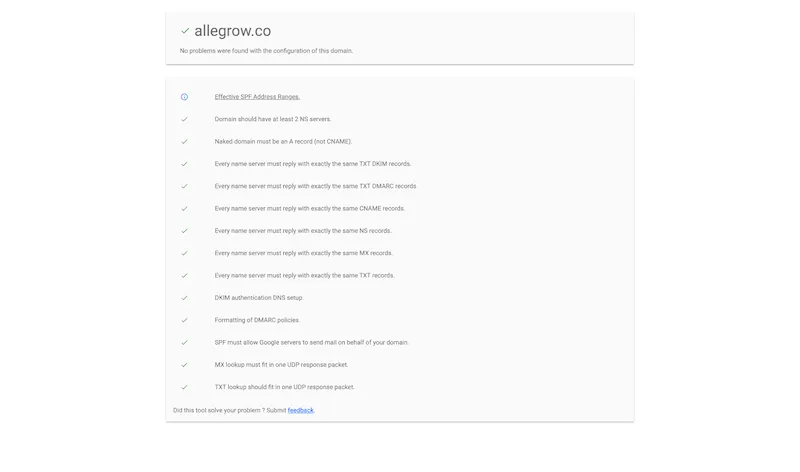 |
If you’re using an Outlook inbox, you can test DMARC, SPF, and DKIM records with a different provider here. (or, if you’re already connected to Allegrow, your mailboxes are checked every hour to make sure they are passing authentication).
DKIM, SPF, and DMARC are critical to demonstrate you’re a responsible sender, and you’ll find it difficult to reach high levels of deliverability without all three protocols in place. So, make sure to follow DMARC reports, check SPF records, and take other steps for improving email performance. This is especially true if you’re in B2B, as there are many filters/security settings on email servers for mid-market and enterprise businesses that prevent emails from being delivered unless they have all three protocols in place.
If you’re unsure how to set up these protocols, you’ll want to start with SPF, following the basic guidance for defining your SPF records here. Then enter the admin panel relevant to your email provider and DNS to generate and add a DKIM record. After both SPF and DKIM are in place, you can proceed with defining and rolling out your DMARC policy.
4. Use High-Quality Contact Data
Being able to target the right prospects at the right companies while avoiding bounces is vital to maintaining a high sender reputation. Using a high-quality contact data provider can help. if you’re not sure where to start or how your current provider stacks up, here are a few of the best:
- Zoominfo: One of the largest B2B contact info providers, they offer leading data coverage while maintaining high quality (including direct mobile numbers). Typically Zoominfo is the best choice for mid-market to enterprise sales and marketing teams.
- SalesIntel: This company offers high-quality contact data and a custom research function that allows larger customers to specify the businesses and job roles they’re looking for. SalesIntel is a top choice for fast-growing teams that use ABM.
- Cognism: Get high-quality contact data specifically for Europe and regions where other providers may lack coverage. The best choice for teams with a focus on EMEA as a market.
Most data providers verify their data set every 90-days, which means it’s important to ensure your data is verified before you contact a prospect.
5. Cleanse Data and Automatically Remove Bounces
Bounces happen to every business occasionally. However, sending cold emails sometimes involves guessing or using purchased email lists, which can lead to high volumes of bounces unless precautions are taken. Therefore, email providers have identified high volumes of bounces as one of the main signals of spam.
 |
To avoid getting your domain flagged for spamming, your overall bounce rate should be less than 1%. These three steps will help you reduce your email bounce rate:
- Make sure your cold email system automatically removes contacts from future emails if they bounce. Close CRM has this setting in place by default across all users.
- Use a data validation provider before adding new contacts to a sequence. List cleaning providers like hunter verify email addresses and flag those likely to bounce so you can remove them from your list. Remember to verify addresses before sending emails, not just once when you receive the data.
- Limit the number of email addresses you message at the same company. Corporate spam filters block emails if you contact multiple people in an organization over a short period of time. Creating these limits can be done in the settings of your contact data provider.
6. Write High-Quality Content (and Test it for Spam Filtering)
If your email doesn’t engage prospects or looks like spam, you’ll have a tough time reaching the main inbox. This is why high-quality content tested for spam filtering is vital.
Additionally, crafting compelling email content can be both time-consuming and challenging. To streamline this process and enhance the quality of your emails, consider using an AI-powered email writer. Our AI Email Writer tool can help you create personalized, engaging emails that resonate with your prospects, ensuring your messages stand out in their inbox.
While there’s no specific formula for creating brilliant content, it starts with a deep understanding of your prospect and testing different approaches. Here are a few best practices to improve email content quality:
- Relevance/Trigger: Using relevant triggers will help your content stand out. This can’t simply be the size of the prospect's company and their industry. Instead, get more specific such as a specific hire they made recently, the content they engaged with on Linkedin or a review they left describing a challenge. You should mention this trigger concisely in your message's first line or two to maximize engagement.
- Length: To count as engagement, the prospect needs to read 100% of your email. If your message is too long, it will get deleted as soon as the prospect opens it. We’ve found keeping the first email in your sequence to 50 or fewer increases general engagement.
- Subject line: When it comes to subject lines, boring = better. Yes, that’s right, having a very boring subject line of 4 words or less produces more engagement than one focusing on your product's benefit. This is because you need to get through the prospects' mental spam filter and their real one. If you want to create effective email subject lines that break through those filters, check out Close's Email Subject Line Generator. Or our cold email subject line guide.
- Size/Attachments: Most corporate spam filters automatically flag with attached files. From the spam filter's perspective this is because the larger a message, the higher the risk. Avoid attaching files and reduce the size of any images—including your logo in your signature.
- Links: Links can cause your message to appear more ‘spammy.’ We recommend including two or fewer links in a cold email (this includes any links in your footer.)
- Footer format: Keep your footer as simple as possible. Include basic information such as name, job title, company name, website, and address. Including your website will be dependent on link usage throughout the rest of your email, and you may want to consider adapting your job title in the footer if it’s one that is heavily linked to prospecting - for example, SDRs, may want to experiment listing themselves as a ‘Partner’ or ‘Associate.’
- Simple CTA: To simplify your CTAs keep them to less than a line and make sure they’re the only line with a question mark to draw attention to the ask. Consider lowering the bar of your ask to simply get a response, rather than booking a meeting right away. Gong found asking for interest in a cold email rather than time is twice as effective.
Finally, use these points as a starting point to create cadences more likely to produce engagement–but don’t be afraid to experiment. What works for you might differ from best practices.
7. Consider Setting Sending Limits Per Mailbox
In addition to increasing your sending volume over time, you’ll also want to either limit outbound emails pre-box or limit the volume of contacts added to your campaigns to avoid looking spammy.
Getting your daily sending volume per mailbox right is a balancing act. The higher your daily volume goes, the greater your risk of receiving multiple manual spam reports, which can lead to inbox suspension.
Follow these guidelines for the maximum volume of emails you should send each day from a single mailbox:
 |
You might be wondering - does this mean it is never safe to send 800 emails per day? The answer is you can, but if you have existing mailboxes and domains, you want to spread this activity across 10 mailboxes based on the ‘Safe’ guidance above.
Note that the maximum volumes we advise for each mailbox vary based on how aggressive/open to risk you are and the type of mailbox you’re using. We’re assuming no one conducting cold outreach is using a free email such as an @gmail.com account - as our guidance is only for commercial users. (Never cold email from a free email account)
8. Send Cold Emails on Subdomains (or Other Root Domains) at Scale
Sending cold emails specifically from different subdomains or root domains altogether has become a common best practice in recent years. This allows you to have greater control and visibility over the sender reputation of the domain being used for prospecting.
Using a different domain or subdomain also decreases the risk for your entire strategy because you aren’t putting all your eggs in one basket. Below is a breakdown of how an email address is made up:
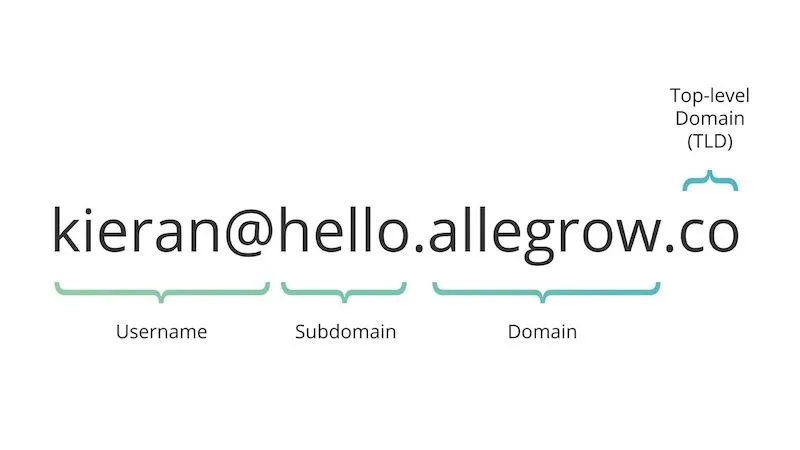 |
Regardless of how careful you are, there is always some level of risk for your sender reputation when sending cold emails. As email providers primarily categorize sender reception on a domain basis, using your core domain could have an impact on other business operations and is a large inconvenience to migrate away from in general.
Therefore, using different subdomains and/or domains lets you hedge your bets and ensure communication to inbound leads and customers receives the maximum level of engagement.
This approach takes a bit more effort to implement but is well worth the investment if you plan to scale outreach to thousands of cold emails each month. Plus, you’re in good company; brands like Apple, Gong, Asana, and Allbirds use subdomains for their email marketing.
9. Use Multi-Channel Sequences for Maximum Engagement
Email is always going to be your top outreach channel - but it’s vitally important to maximize engagement across your sequences, so email isn’t your ONLY outreach channel.
Why? Using multiple channels increases your exposure to prospects and the number of follow-ups you can send a single contact without increasing your spam risk. It’s no secret that the more unanswered follow-ups you send to a prospect, the more likely they are to manually report your messages as spam. Using multiple channels helps increase familiarity and maximizes your engagement without increasing email volume.
Examples of some of the main channels you’ll want to add to your sequences if you aren’t already using them:
LinkedIn Connection requests + DMs: It’s important to execute Linkedin prospecting correctly. Rather than just connecting and pitching, aim to get a response and build engagement:
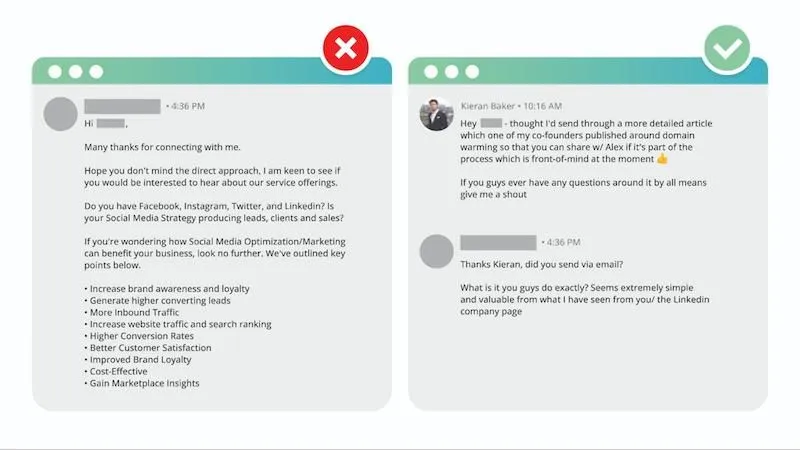 |
Calls: Some sales teams try to shy away from making outbound calls, but they still work well. This separates you from the crowd of companies too scared to start a conversation.
Direct Mail: Services like Alyce and Reachdesk allow you to send packages during prospecting. This is a great fit for accounts that you expect to convert to high-value customers. Increased engagement on these key accounts will help increase the reputation of your domain, so even the communications you send to prospects that aren’t receiving these gifts are likely to be more impactful.
Voice notes / Videos: Creating personalized voice messages from a script makes you seem more human, which is one of the fundamental steps to getting a response and more engagement:
 |
Social Selling: This subject gets a lot of hype, but people rarely do it authentically inside a sequence. Here’s a great example: We were in the sales process for Nylas when their their AE noticed our company was hiring and posted the following message:
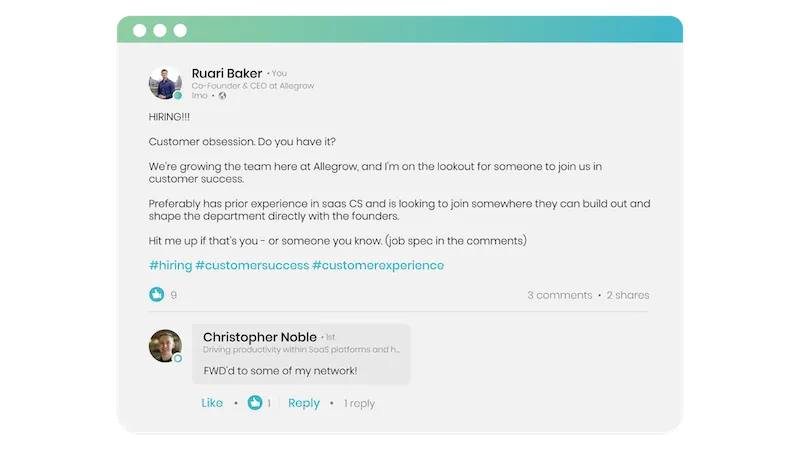 |
This was just one more touch point to keep their proposal top of mind without sending a follow up message.
The key to doing this consistently is a task step in your cadence to review the prospect's company and contact profiles on Twitter and Linkedin, then to share/comment genuinely on something they post.
10. Use a Warm, Personal Tone in Follow-up Emails
Usually, the quality of follow-up emails has a serious drop-off compared to the opening email in the sequence.
I often get a few emails every day that say something along the lines of, ‘Did you see my last email?’, ‘I didn’t hear back from you’ or ‘Thoughts?’ Some of these emails used to work well (I’ve been guilty of a few one-line follow-ups in the past), but in 2022 it's overused and annoying–and likely to land your email in the spam folder.
The primary issue with these cold, short follow-ups is they put the focus on you rather than the prospect. In fact, shorter follow-up emails are 15x less likely to help you book a meeting.
To keep your follow-up emails a bit warmer, here are some examples of the kinds of changes you could make to your current follow-up sequence:
Follow-up 1: change ‘Did you see my last email’ to ‘Would you say you’re similar to XYZ?’:
 |
Follow-up 2: Change ‘I’ve reached out to you a couple of times’ to ‘Did you notice a change when ABC occurred?’:
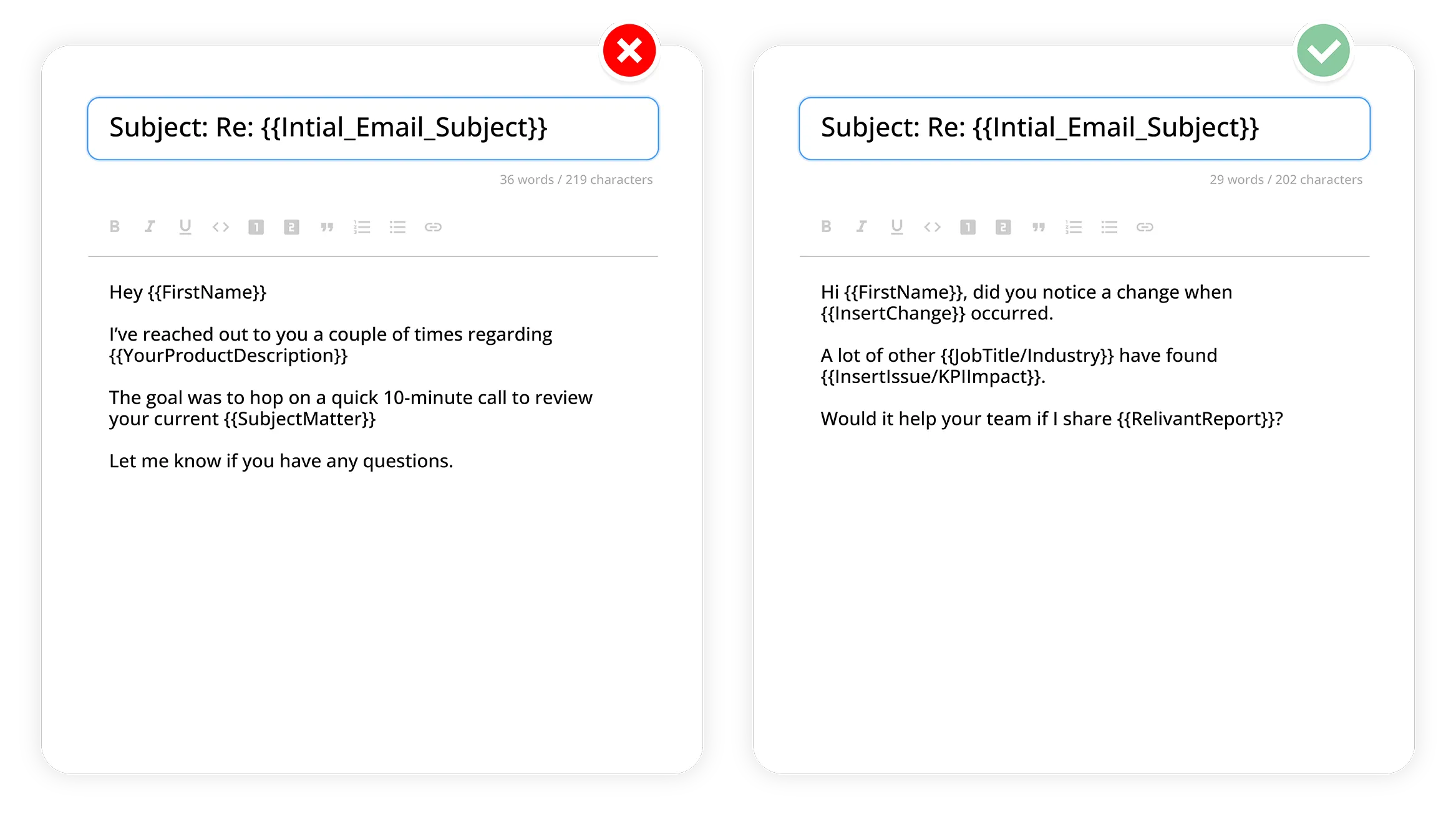 |
Follow-up 3: Change ‘Break-up email’ to ‘I made a mistake - is X more focused on this’:
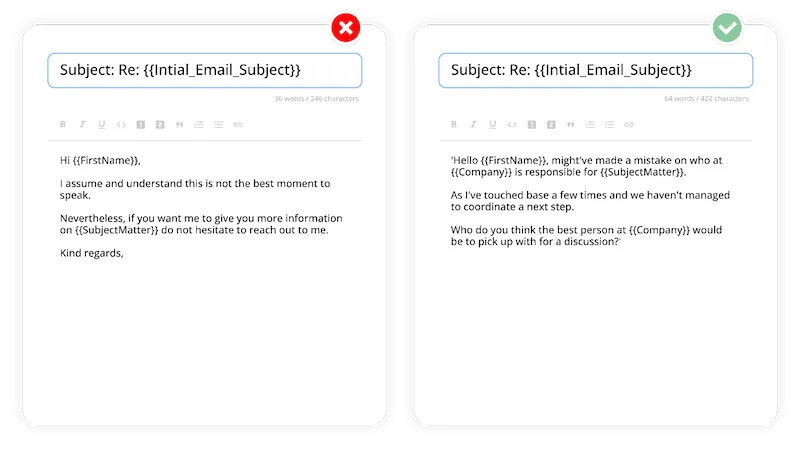 |
By bringing your follow-up emails up to the same standard as your initial email and avoiding a pestering tone, you’re more likely to get a response.
11. Create a Disengagement Trigger
The more disengaged your list, the worse your sender reputation will be. Top-performing senders optimize messages to maximize engagement on each email they send.
The most common mistake made related to engagement is continuing to message contacts after they’ve become disengaged. Keeping contacts on a list after they’ve stopped listening can cost you deliverability to new prospects who may be a better fit and more engaged. We call this disengaged segment ‘dead weight.’
The obvious solution is to remove disengaged contacts from your list. But, judging when someone becomes disengaged is easier said than done.
Here are some general best practices to know when to stop sending prospects emails:
 |
How you enforce these rules will depend on your CRM/sales engagement solution. In Close CRM, for example, this can be achieved using SmartViews to regularly segment contacts that meet those criteria and remove them from sequences in bulk:
 |
Implementing these rules creates higher general engagement and reduces the risk of contacts reporting your emails as spam. All that leads to a better overall score and a more effective warm up process on your domain.
12. Send Emails Individually, Not Through a Third-Party SMTP
To get the highest open and reply rates, you’ll want to send emails on a one-to-one basis through Google Workplace or O365 email accounts specifically set up for prospecting. This means you won’t want to use a third-party delivery service / SMTP server for cold email
Using a third-party SMTP means you’re sending emails through a server/service like AWS or SendGrid–which are intended for opt-in communications, and email providers scrutinize content from third-party SMTP servers more closely than individual email accounts.
Email providers are more likely to heavily filter content sent via third-party servers because third-party servers have the capability to deliver emails to an unlimited number of recipients over a short period of time–which is far more likely to be used for mass spamming and phishing campaigns than one-to-one emails.
To check if your current set-up is running through a third-party server, just check the sent folder of your cold email mailboxes. If you see messages are being sent individually, you’re using one-to-one outreach (as we’d advise.) If you can’t see the sent messages anywhere, you’re probably on a third-party service and will need to move towards using your email client directly.
Moving to one-to-one outreach vastly reduces your volume and increases the time it takes to contact every prospect. However, you’ll yield better long-term results!
13. Monitor Spam Reporting in Google Postmaster Tools
Google Postmaster Tools (GPT) helps you monitor the sentiment of prospects who use GSuite. Since Google is one of the most popular email providers, especially in the B2B segment, this is a great resource to see if people are reacting negatively to your messages.
Note: GPT will not provide data on the percentage of your emails being automatically filtered into spam (you’ll need an inbox placement provider to figure that out), but it can give you an idea of how many prospects manually flag your messages as spam.
This can help you understand if the messages/follow-ups you’re sending are too aggressive so you can adapt your approach when you see spikes. One of the biggest issues with relying solely on GPT is if messages are automatically filtered to spam you’re not likely to see any spikes in reports (because people can’t manually report emails as spam if they're already in that folder!)
14. Always A/B Test Your Cold Emails
Running consistent A/B tests will help your cold outreach activity look less robotic and prevent content from becoming stale. There are two primary types of A/B tests to be aware of and use:
- Live Variations: Send multiple versions of the same email to prospects in real-time. To do this, simply create an alternative version of your template directly in your sales engagement platform and add it to your sequence:
 |
2. New structure tests: Testing a new structure involves creating an alternative version of your email, usually with more drastic changes (e.g., eliminating all links). Applications like Allegrow let you test how often each version is filtered into spam, which can help firm up the technical soundness of these drastic changes before they go live (as you ideally don’t want to be practicing on your prospects):
 |
Start off implementing around three live variations for the same sequence email to test prospects' sentiment towards the email (i.e., tracking which receives more positive responses). You’ll want to conduct new structure tests every 30-days with the goal of changing your overall template at least every 60-days to avoid your messages getting stale.
Results from (Real) Email Warm Up Campaigns that Work
Warm up campaigns done well with a quality warm up provider result in higher open and response rates. Close user Ramzi Malas from Lux Sales Consulting saw their open rates increase 30-50% using Allegrow for email warm up:
FAQs About Warming Up Email Accounts Before Outreach
What makes a quality email warm up provider?
There are several key functionalities the best top warm up providers offer, and without them, you’ll be at a disadvantage. These include:
- Real Business Domains (not fake seed accounts): A lot of warm up platforms use ‘seed accounts’ / ‘private networks’, which are purchased or set up in bulk by the warm up provider. The problem is those email addresses are not unique domains or made from real business inboxes (ESPs know when an account is fake.) Therefore the data on inbox placement is inaccurate and doesn’t help to improve inbox placement. Other providers like Allegrow build their network from thousands of unique B2B inboxes (meaning other Allegrow users' real inboxes!) so the network can simulate engagements safely and provide accurate data across the board.
- Significant sample size: Many testing platforms either send a low volume of emails, meaning under 100, and calculate reputation from this data or send one batch of emails rather than continually sending emails over time and calculating an average reputation score based on multiple data points. These solutions will be ok to use for free if you’re just getting started. However, if you’re a pro marketer, these sample sizes aren’t statistically relevant compared to the number of emails you send.
- Separate monitoring and interaction relationships: Some warm up tools use the same domains to measure reputation and engagement. This means the email domains that respond to your emails, move them out of spam, mark them as important and so on, are the same domains that calculate your email reputation over time. The issue is that email domains have a ‘memory.’ Meaning, if you have a low reputation and send an email to me tomorrow that lands in spam but I move your email out of spam, even if your reputation rate doesn’t change, future emails you send to my inbox are unlikely to land in spam as my preference to interact with you is remembered. Therefore, platforms that use the same mailboxes for both interacting and monitoring will inevitably show less accurate reputation data over time. Separating monitoring relationships from interaction relationships means your data will be accurate in the long term.
- Content testing: How do you keep getting benefits from inbox placement/warm up tools if your sender reputation is above average? With most warm up providers, that’s where the journey ends. However, the best email warm up content providers also offer content testing, which allows you to test different variations of your content against real B2B inboxes and compare where each version is placed by email providers. This feature helps you improve your email marketing long-term.
What is a good open and response rate for cold email?
Email open rates of above 27% are average, with top-performing outreach sequences hitting 50% or higher. Response rates of 12% or more across your sequence show you’re engaging with the right prospects and have good inbox placement.
Looking to enhance your B2B outreach? Check out our article on 12 B2B Cold Email Templates, where we explore the nuances of creating effective b2b cold email templates.
How do I integrate an email warm up tool with my CRM / Sales Engagement?
Check with the specific warm up provider you’re using to see how well they work alongside your email provider and Sales Engagement platform. As an example, Allegrow integrates with all major email providers for B2B users and directly integrates to Close Instructions on setting up the integration are available here.
As a marketer, your CRM platform plays a crucial role in your ability to reach and engage with your target audience. Learn about the best CRMs for marketers in this article.
How long does it take to warm up an email?
Email warm up is not something you do once and then are done. To reach a high level, you’ll need to continue training/conducting the process in the long term. For best results, start using a quality warm up system at least 30-days before starting outreach and continue warming up for as long as your domain is used for sales and marketing.
How can I calculate what percentage of my emails land in spam?
Some sending platforms provide ‘spam reports’ or ‘undeliverable’ / ‘bounce reports’. These do not tell you how many emails land in spam folders. That's because the majority of emails that land in spam are automatically filtered. The only way to see how many emails land in spam is to monitor where. Warm up solutions do this in three steps:
- Emails are sent from inboxes on your domain to external emails.
- The provider is connected to these inboxes so they can check where emails land. (THis means they can count the quantity that landed in spam, promotion, junk, or unfocused folders.)
The volume of emails that lands in these folders compared to the overall volume sent is turned into a reputation percentage and reported back to you.










